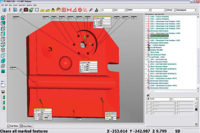
Machining the thrust walls on cam-shafts and crankshafts is both a critical operation and a problem-atic one. Correct thrust wall geometry and superior surface finish are vital to engine performance. But traditional alternatives for getting the job done right have been costly or inefficient. Now, thanks to a new process known as kiss grinding, thrust wall surfaces in some plants are getting the tender loving care they de-serve, resulting in high quality products made more quickly and at lower cost.
Typically, perpendicular features like thrust walls on crankshafts and camshafts have been finished by either turning or plunge grinding. Both approaches have their drawbacks.
Taking a thin turning cut on these hard features often results in problematic "bird's nest" chips, leading to frequent tool changes and a consequent loss of productivity. Costs associated with poor tool life also are experienced, and quality suffers as well, especially in the areas of surface finish and geometry. In addition, the fillet rolling operation--performed on crankshafts after the turning process to place in relief the corner formed by the pin and the thrust face--can distort precisely machined side walls, leading to a loss of perpendicularity.
With grinding, by contrast, fillet rolling is performed before the grinding operation. And plunge grinding can accurately control perpendicularity of side walls and eliminate tool life problems associated with turning. The problem is that plunge grinding is a relatively costly process, typically done on large, expensive dual angle-head machines using 750-millimeter diameter aluminum oxide grinding wheels, or on straight plunge grinders with large, 1,065-millimeter diameter wheels that requires frequent dressing--typically after every part.
Finding a better way
In 1998, Landis Gardner (Waynesboro, PA) launched a major effort to develop an alternative method that would overcome the size, complexity and cost disadvantages of the plunge grinding process. Chief among the alternatives evaluated was using the side of the grinding wheel to finish grind the cam and crank thrust faces. This wasn't a new technique--tool and die makers had been using it for years to finish perpendicular features. The challenge was to turn the technique into a precisely controllable, high-volume production process.
The development team's experience with superabrasive cubic boron nitride (CBN) grinding wheels aided the quest. The long life and even wear pattern of CBN grinding wheels made them logical candidates for this sort of application.
To determine the feasibility of the side wheel thrust wall grinding process, extensive grinding tests were performed in a process development lab to determine the effects of variables such as pressure, wheel shape and grade, speed and different types of coolant on CBN grinding wheel life. Part quality and cycle Arial also were evaluated. The result was the introduction of a CBN thrust wall grinding process dubbed "kiss" grinding because of the way the wheel gently touches the thrust wall.
Kiss grinding uses a narrow rimmed CBN wheel--either vitrified bond CBN with water-soluble coolant or plated CBN with mineral oil--to grind thrust walls and thrust collars. Kiss grinding thrust walls with a grinding wheel that has CBN material on the sides of the wheel can be two or more times faster than plunge grinding and still meet customer requirements in terms of geometry and surface finish. Because the CBN wheel wears evenly, the part grinds flat every time, reducing downtime for dressing and wheel change by approximately 50%.
The process can produce perpendicular side walls or even a concave surface, depending on the grinder's setup. Kiss grinding also provides better control of flange face spacing. And the likelihood of burn on the flange face--a problem with grinding operations performed on an angle-head ma-chine--is effectively eliminated. Further, when vitrified bond CBN wheels are used, the kiss grinding pro-cess also is more environmentally friendly than alternate methods that use plated wheels with oil coolant.
One machine, many uses
Kiss grinding with a single CBN wheel also offers greater flexibility than conventional machining methods, while providing a more robust process. The same machine used for kiss grinding of thrust walls can be used for other processes, for example. With a twin-wheelhead thrustwall grinder, all concentric diameters, thrust walls and the flange face of crankshafts can be processed on the same grinding machine by stitch-grinding the concentric diameters with one wheel and kiss grinding the thrust walls using a different wheel on the second spindle.
Another advantage comes in space savings. A straight wheelhead machine developed for kiss grinding can require about 30% less floorspace than the traditional dual angle-head grinders, with a lower life cycle cost as well. With the option of computer numerical control swivel, flange faces can even be produced with slightly concave surfaces, giving engine designers an additional option.
They like it
Though new, the kiss grinding technique has already been applied with positive results. Several manufacturers now routinely kiss grind cam and crank thrust walls, as well as the thrust collars on intake and exhaust camshafts using a single twin-wheelhead machine. The approach saves time, space and investment, while improving quality.
Kiss grinding is initially proving attractive to manufacturers be-cause of its potential process economies, including the elimination of the effects of tool wear, tool change downtime and the dressing of aluminum oxide wheels. Also, when water-soluble coolant is used, it is an environmentally friendly process.
Possibly more important in the future, however, is the fact that kiss grinding may be the only way of meeting the more stringent geometry requirements that the automakers will likely soon be requiring in order to boost engine efficiency.
Kiss grinding, which employs a narrow rimmed CBN grinding wheel, is emerging as an alternative to turning or plunge grinding in the processing of camshafts and crankshafts. Its proponents claim it is a more efficient way of machining perpendicular features on the thrust walls of crankshafts and camshafts, providing better control of flange face geometry and virtually eliminating the risk of thermal damage to the parts.
